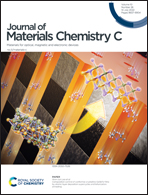White vertical organic permeable-base light-emitting transistors obtained by mixing of blue exciton and orange interface exciplex emissions†
Abstract
In contrast to passive organic devices, such as organic light-emitting diodes and organic solar cells, which require a transistor in electrical circuits to modulate in/out-put signals and/or to reduce parasite resistivity, organic light-emitting transistors expectedly have the highest market potential of all organic electronic devices, including for high-density logic applications and novel multifunctional photonic circuits. In this work, we aimed to develop white organic light-emitting transistors exploiting a vertical device structure on a permeable base. Before the fabrication of white vertical organic permeable-base light-emitting transistors (OPB-LETs), orange and blue exciplex-based OPB-LETs were studied using known exciplex emitters. Due to electron injection problems, these emitters did not show white electroluminescence in OPB-LETs. When a newly synthesised blue emitter 4,6-bis(4-(9H-carbazol-9-yl)phenyl)pyrimidine-5-carbonitrile (CzPm) with orange exciplex forming ability was used, white electroluminescence from OPB-LETs was achieved by mixing of the blue exciton and orange exciplex emissions. Orange exciplex CzPm:TAPC with the photoluminescence spectrum peaking at 558 nm was characterized by thermally activated delayed fluorescence. The white OPB-LETs demonstrated a maximum external quantum efficiency of 2.4%, CIE colour coordinates in the range of (0.31, 0.38)–(0.34, 0.36), and colour rendering index in the range from 77 to 93.



 Please wait while we load your content...
Please wait while we load your content...